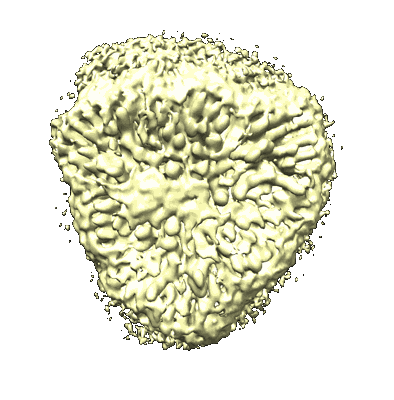EMD-35784
Cryo-EM structure of unprotonated LHCII in detergent solution at low pH value
EMD-35784
Single-particle2.52 Å
 Deposition: 31/03/2023
Deposition: 31/03/2023Map released: 06/09/2023
Last modified: 04/10/2023
Sample Organism:
Spinacia oleracea
Sample: LHCII in detergent solution at low pH value
Fitted models: 8iwz (Avg. Q-score: 0.563)
Deposition Authors: Ruan MX, Ding W
Sample: LHCII in detergent solution at low pH value
Fitted models: 8iwz (Avg. Q-score: 0.563)
Deposition Authors: Ruan MX, Ding W

Cryo-EM structures of LHCII in photo-active and photo-protecting states reveal allosteric regulation of light harvesting and excess energy dissipation.
Ruan M  ,
Li H,
Zhang Y
,
Li H,
Zhang Y  ,
Zhao R,
Zhang J
,
Zhao R,
Zhang J  ,
Wang Y,
Gao J
,
Wang Y,
Gao J  ,
Wang Z,
Wang Y,
Sun D,
Ding W
,
Wang Z,
Wang Y,
Sun D,
Ding W  ,
Weng Y
,
Weng Y 
(2023) Nat Plants , 9 , 1547 - 1557
 ,
Li H,
Zhang Y
,
Li H,
Zhang Y  ,
Zhao R,
Zhang J
,
Zhao R,
Zhang J  ,
Wang Y,
Gao J
,
Wang Y,
Gao J  ,
Wang Z,
Wang Y,
Sun D,
Ding W
,
Wang Z,
Wang Y,
Sun D,
Ding W  ,
Weng Y
,
Weng Y 
(2023) Nat Plants , 9 , 1547 - 1557
Abstract:
The major light-harvesting complex of photosystem II (LHCII) has a dual regulatory function in a process called non-photochemical quenching to avoid the formation of reactive oxygen. LHCII undergoes reversible conformation transitions to switch between a light-harvesting state for excited-state energy transfer and an energy-quenching state for dissipating excess energy under full sunshine. Here we report cryo-electron microscopy structures of LHCII in membrane nanodiscs, which mimic in vivo LHCII, and in detergent solution at pH 7.8 and 5.4, respectively. We found that, under low pH conditions, the salt bridges at the lumenal side of LHCII are broken, accompanied by the formation of two local α-helices on the lumen side. The formation of α-helices in turn triggers allosterically global protein conformational change, resulting in a smaller crossing angle between transmembrane helices. The fluorescence decay rates corresponding to different conformational states follow the Dexter energy transfer mechanism with a characteristic transition distance of 5.6 Å between Lut1 and Chl612. The experimental observations are consistent with the computed electronic coupling strengths using multistate density function theory.
The major light-harvesting complex of photosystem II (LHCII) has a dual regulatory function in a process called non-photochemical quenching to avoid the formation of reactive oxygen. LHCII undergoes reversible conformation transitions to switch between a light-harvesting state for excited-state energy transfer and an energy-quenching state for dissipating excess energy under full sunshine. Here we report cryo-electron microscopy structures of LHCII in membrane nanodiscs, which mimic in vivo LHCII, and in detergent solution at pH 7.8 and 5.4, respectively. We found that, under low pH conditions, the salt bridges at the lumenal side of LHCII are broken, accompanied by the formation of two local α-helices on the lumen side. The formation of α-helices in turn triggers allosterically global protein conformational change, resulting in a smaller crossing angle between transmembrane helices. The fluorescence decay rates corresponding to different conformational states follow the Dexter energy transfer mechanism with a characteristic transition distance of 5.6 Å between Lut1 and Chl612. The experimental observations are consistent with the computed electronic coupling strengths using multistate density function theory.
